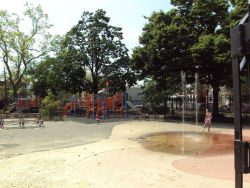Martin Luther King Jr. Playground
Dr. Martin Luther King, Jr. Park
Rev. Dr. Martin Luther King, Jr. (1929-1968) was a pivotal figure in the civil rights movement who became famous in the 1950s and 1960s for his advocacy of nonviolent resistance in the struggle against racism. Descended from a long line of ministers, King was a child prodigy who entered Morehouse College at 15 and was ordained a minister of the Baptist Church four years later. As pastor of the Dexter Avenue Church in Montgomery, Alabama, King earned a reputation as an eloquent and committed opponent of intolerance. He was elected President of the Montgomery Improvement Association and led the successful Montgomery bus boycott of 1955 to 1956.
King resigned from the Dexter Avenue Church in 1959 and founded the Southern Christian Leadership Conference, an organization devoted to challenging racism with nonviolent civil disobedience. In 1963, he organized a historic march on Washington, which brought more than 200,000 together to support proposed civil rights legislation. There he delivered his famous "I Have a Dream" speech. Also in 1963, King wrote “Letter From a Birmingham Jail,” describing not only his quest for justice through nonviolent means, but also his frustration with the mindset of those willing to accept the status quo without question.
Mohandas Karamchand Gandhi (1869-1948), the Indian nationalist leader, also called Mahatma (great soul), deeply influenced King’s thinking. Faced with racial strife and violence, King advocated nonviolent protest, believing that a noble end did not justify immoral means. Just as Gandhi established his country's freedom through a nonviolent revolution, King used peaceful marches and sit-ins to bring attention to discrimination and injustice. In 1964, King was awarded the Nobel Peace Prize for his efforts.
Martin Luther King, Jr. was assassinated on April 4, 1968, in Memphis, Tennessee, and a career criminal, James Earl Ray, confessed to the killing. King’s courage and perseverance continue to inspire admirers all over the world. He is remembered as one of the great American heroes of 20th century, a man who devoted his life to fostering tolerance and equality on the grounds that “injustice anywhere is a threat to justice everywhere.”
The City of Brooklyn purchased this property from the German-American Improvement Company in 1896 and named it Linton Park. The consolidation of New York City in 1898 caused this and all of Brooklyn’s parklands to be placed under the jurisdiction of the city. Soon after King’s death, several city leaders proposed renaming this park in honor of the martyred civil rights leader. In a memo circulated to support the name change, King was described as “an outstanding representative of all America” and “an eloquent spokesman for the humanitarian ideals of universal peace and freedom.” The property was officially renamed Dr. Martin Luther King, Jr. Park by local law on May 29, 1970. The park contains benches, play equipment with safety surfacing, a flagpole with yardarm, a public restroom, spray shower, swings for tots, basketball and handball courts, a drinking fountain, and grassy play area. In 1997, Mayor Giuliani funded a $95,225 renovation to furnish new play equipment and safety surfacing for the park.
Check out your park's Vital Signs
Clean & Safe
Green & Resilient
Empowered & Engaged Users
Share your feedback or learn more about how this park is part of a
Vital Park System

